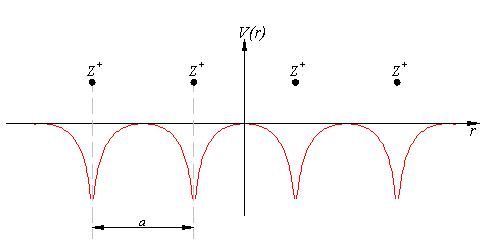In
quantum mechanics
Quantum mechanics is a fundamental theory in physics that provides a description of the physical properties of nature at the scale of atoms and subatomic particles. It is the foundation of all quantum physics including quantum chemistry, ...
, the particle in a one-dimensional lattice is a problem that occurs in the model of a periodic
crystal lattice
In geometry and crystallography, a Bravais lattice, named after , is an infinite array of discrete points generated by a set of discrete translation operations described in three dimensional space by
: \mathbf = n_1 \mathbf_1 + n_2 \mathbf_2 + n ...
. The potential is caused by
ion
An ion () is an atom or molecule with a net electrical charge.
The charge of an electron is considered to be negative by convention and this charge is equal and opposite to the charge of a proton, which is considered to be positive by conven ...
s in the periodic structure of the crystal creating an
electromagnetic field
An electromagnetic field (also EM field or EMF) is a classical (i.e. non-quantum) field produced by (stationary or moving) electric charges. It is the field described by classical electrodynamics (a classical field theory) and is the classical c ...
so electrons are subject to a regular potential inside the lattice. It is a generalization of the
free electron model, which assumes zero potential inside the lattice.
Problem definition
When talking about solid materials, the discussion is mainly around crystals – periodic lattices. Here we will discuss a 1D lattice of positive ions. Assuming the spacing between two ions is , the potential in the lattice will look something like this:

The mathematical representation of the potential is a periodic function with a period . According to
Bloch's theorem,
the wavefunction solution of the
Schrödinger equation
The Schrödinger equation is a linear partial differential equation that governs the wave function of a quantum-mechanical system. It is a key result in quantum mechanics, and its discovery was a significant landmark in the development of the ...
when the potential is periodic, can be written as:
where is a
periodic function
A periodic function is a function that repeats its values at regular intervals. For example, the trigonometric functions, which repeat at intervals of 2\pi radians, are periodic functions. Periodic functions are used throughout science to desc ...
which satisfies . It is the Bloch factor with Floquet exponent
which gives rise to the band structure of the energy spectrum of the Schrödinger equation with a periodic potential like the Kronig–Penney potential or a cosine function as in the Mathieu equation.
When nearing the edges of the lattice, there are problems with the boundary condition. Therefore, we can represent the ion lattice as a ring following the
Born–von Karman boundary conditions. If is the length of the lattice so that , then the number of ions in the lattice is so big, that when considering one ion, its surrounding is almost linear, and the wavefunction of the electron is unchanged. So now, instead of two boundary conditions we get one circular boundary condition:
If is the number of ions in the lattice, then we have the relation: . Replacing in the boundary condition and applying Bloch's theorem will result in a quantization for :
Kronig–Penney model
The Kronig–Penney model (named after
Ralph Kronig and
William Penney
William George Penney, Baron Penney, (24 June 19093 March 1991) was an English mathematician and professor of mathematical physics at the Imperial College London and later the rector of Imperial College London. He had a leading role in the d ...
) is a simple, idealized quantum-mechanical system that consists of an infinite periodic array of
rectangular potential barrier
In quantum mechanics, the rectangular (or, at times, square) potential barrier is a standard one-dimensional problem that demonstrates the phenomena of wave-mechanical tunneling (also called "quantum tunneling") and wave-mechanical reflection. ...
s.
The potential function is approximated by a rectangular potential:

Using
Bloch's theorem, we only need to find a solution for a single period, make sure it is continuous and smooth, and to make sure the function is also continuous and smooth.
Considering a single period of the potential:
We have two regions here. We will solve for each independently:
Let ''E'' be an energy value above the well (E>0)
* For
:
*For
 The mathematical representation of the potential is a periodic function with a period . According to Bloch's theorem, the wavefunction solution of the
The mathematical representation of the potential is a periodic function with a period . According to Bloch's theorem, the wavefunction solution of the  Using Bloch's theorem, we only need to find a solution for a single period, make sure it is continuous and smooth, and to make sure the function is also continuous and smooth.
Considering a single period of the potential:
Using Bloch's theorem, we only need to find a solution for a single period, make sure it is continuous and smooth, and to make sure the function is also continuous and smooth.
Considering a single period of the potential: Using Bloch's theorem, we only need to find a solution for a single period, make sure it is continuous and smooth, and to make sure the function is also continuous and smooth.
Considering a single period of the potential:
Using Bloch's theorem, we only need to find a solution for a single period, make sure it is continuous and smooth, and to make sure the function is also continuous and smooth.
Considering a single period of the potential: